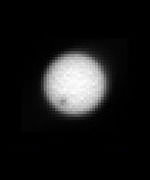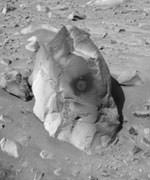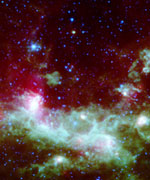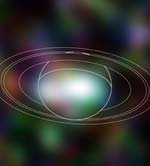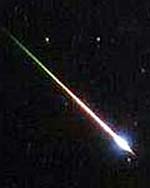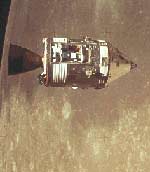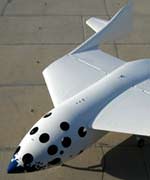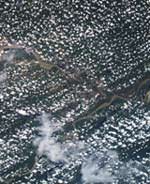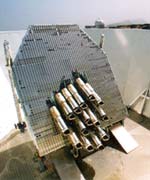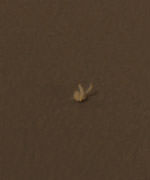
Image credit: NASA/JPL
Like a rabbit in a hat, the identity of an oddity that looks like “bunny ears” in a picture from Mars has eluded the science and engineering teams.
The public, also fascinated with the mysterious object, has asked in a slew of e-mails: What is it?
It is a yellowish object measuring about 4 to 5 centimeters (about 2 inches) long that made its debut when Opportunity’s eyes welcomed Earth to a new neighborhood on Mars in her mission success panoramic image. Meridiani Planum is a landscape unlike any other stop on our decades-long tour of the red planet. Still, it wasn’t the conspicuous bedrock outcropping near the horizon that initially fascinated many people. It was the “bunny ears.”
Bemused by Bunny
Temporarily sharing a large workroom in the building that houses rover mission control, engineers were still meticulously reconstructing the events of entry, descent and landing and scientists were anxiously poring over the pictures their most recently successful twin was returning.
Jeff Johnson, a scientist from the U.S. Geological Survey and a member of the panoramic camera team, heard from others about a small, fuzzy-looking object in the mission success panorama. Viewing the image on his computer screen, Johnson wondered aloud, “What in the world is this?” Colleagues gathered around his computer table, trying to make sense of the oddity.
Most team members agreed that the “bunny ears” had been, at some point, part of the rover or its lander. The yellowish color led many to conclude that the object was a piece of airbag material.
The Mars Pathfinder mission set a precedent in 1997 for puzzling pieces around the landing site. An object dubbed “Pinky” caught the attention of the Pathfinder science team and the public. Although never positively identified, it was thought to be a piece of Kapton tape – an adhesive used often in aerospace applications.
How Did They Track the Mysterious Object?
To further complicate the Meridiani mystery, when Johnson tried to image the quirky “ears” at higher resolution, they had vanished from where they were originally spotted – about 4.5 meters (15 feet) from the lander. Johnson, intrigued by their disappearance, was good-naturedly assigned by Steve Squyres (the mission’s principal investigator) to “track the bunny.” He discovered that the object was visible in navigation camera images acquired on landing day – but lying a meter (about 3 feet) further from the lander, up the crater slope. Using JPL-designed software, scientists are able to measure the “bunny ears” in each image where they appear. The object is about the same size in every image.
“After looking at pictures of Opportunity’s lander up-close, I think we might have, again, spotted the bunny,” said Johnson. “It looks as if the object has been blown under the north-facing egress ramp.”
Johnson and his colleagues believe that a light wind whirling from the north over Opportunity’s Challenger Memorial Station landing site could have transported the article. Its small size indicates that it would be easily carried by even a light wind. The three-color Pancam images acquired of the object as part of the mission success panorama even showed some evidence that the object moved slightly between images from the gentle wind. Johnson estimates that the breeze pushed the “bunny ears” an estimated 5 to 6 meters (about 16 to 20 feet).
“There’s no evidence of a mark that it left in the soil as it moved,” Johnson noted. “It was light enough and small enough to not leave any footprints’.”
If Not a Bunny, Then What?
Without seeing the “bunny ears” object up close with our own eyes, it’s difficult to provide a positive identification. However, scientists and engineers are quick to deflate the myth that it is anything inexplicable.
“Our team believes that this odd-looking feature is a piece of soft material that definitely came from our vehicle,” said Rob Manning, lead engineer for entry, descent and landing. “We cannot say exactly where it came from but we can say that there are several possibilities: cotton insulation, Vectran covers and wraps from the airbag, Zylon bridle tensioning ties, or felt insulation from the gas generators…. The list goes on. We do not think this is parachute material, however, due to its color (it does not look blue enough to be the undyed nylon or red enough to be the dyed nylon).
Knowing the possibility that we could have left a bit of a mess nearby, once we saw this feature we only marveled at how clean everything looked and we have not given it another thought. We try to make sure that bits do not fall off, but they do, and we were not at all surprised.”
Johnson took the visual color clues a step further. He measured the visible light spectrum from the Pancam image of the “bunny ears” and compared it to the spectrum of a sample of airbag material. The nearly identical spectra are distinct from typical martian soil or rock spectra and lead Johnson to believe that the “bunny ears” are, indeed, a wayward piece of airbag material or something similar.
Original Source: Astrobiology Magazine

